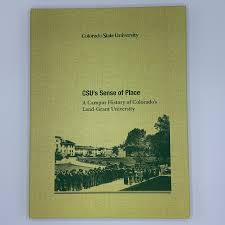
by James E. Hansen II, Gordon A. Hazard, Linda M. Meyer, 2018
Very complete book giving pictures and history of EVERY building and even the places of Colorado State University. Especially liked the pictures of the first buildings in the late 1800s (the Pioneer Era from 1870-1909). They divided it into The Pioneer Era (1870-1909), Charles A. Lory Era (1909-1940), William E. Morgan Era (1949-1969), Modern University Era (1969-1990), and Digital Era (1990-2017). I especially liked:
1. Jesse Harris Spring (1901-present): stone fountain that is still standing to the north of Spruce Hall (on 100 block of Old Main Drive), donated by Jesse Harris, former Fort Collins mayor and State Board of Agriculture member. The water was piped from Bailey’s Spring, located on land in the foothills. “Many local citizens distrusted the city’s tap water and believed that the spring had medicinal qualities. They filled jugs at the Jesse Harris Spring to take home for drinking. The fountain proved its worth when an outbreak of typhoid was traced to the city supply, and the high sulfur content kept the spring water safe to drink…By 1921, the old iron pipes had rusted. The cost of pipe replacement, and the fact that the spring was running dry, led the administration to quietly decide that the Jesse Harris Spring should be connected to the city water tap…”
2. Every tennis court ever located at CSU. The first were three dirt courts in 1908. The courts Wayne played on while in college existed from 1961 until 2009; eight courts directly east of what would become Moby Arena. The current 12 courts located on Research Boulevard cost $2 million and opened in 2010. It is considered “one of the nation’s finest college facilities.”
3. Quonset huts that were used as housing for veterans from 1946-1961. Carla lived in one of these when she was a baby.
4. The dairy farm was originally the Hahn Farm which I think was located near West Prospect and South Shields Street, then moved in 1981 to north of the Veterinary Teaching Hospital, but closed in 1989 due to financial losses and complaints of odors.
5. Hughes Stadium: Pat Stryker gave $15 million towards it in 2003 to honor both Albert Yates and Sonny Lubick. Hughes Stadium existed from 1968 to 2017, the last playing season was 2016. The book was published before it was decided to make Hughes Stadium area into a residential development.
6. Includes pictures of Old Main, including after the fire on Friday, May 8, 1970. Someone started it in protest of the Vietnam War. The picture shows all that was left of this beautiful building was the brick and stone shell. It’s a haunting picture. What a terrible loss.
7. The new stadium – the most controversial facility ever built on campus. Funding fell short but even so, the Board of Governors authorized $239 million to build the structure, which opened in fall of 2017.
8. The Mountain Campus, 1914-present: originally named after “George W. Pingree (a Civil War veteran and participant in the infamous Sand Creek Massacre), who ran a logging camp there from 1868 to 1870 to supply railroad ties for the Union Pacific Railroad.”
An excellent book – I love the old pictures from back in the 1870s to early 1900s.